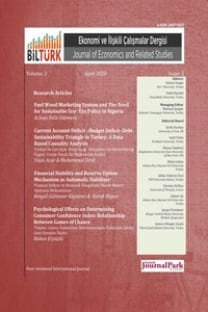Apple Doesn't Fall far: Intergenerational Education Mobility in Turkey
Anahtar Kelimeler:
Intergenerational Mobility, Education, Human Capital
Apple Doesn't Fall far: Intergenerational Education Mobility in Turkey
This study presents an in-depth review of the literature on intergenerational education mobility. The issues regarding consistent estimation of mobility coefficients as well the proposed solutions are elaborately discussed. In the light of the discussions, the strength of the intergenerational schooling association in Turkey is analyzed for father-son and father-daughter samples separately using a pooled sample of pairs living in the same household in any of the years between 2003 and 2011. The results suggest large persistence in intergenerational schooling—paternal and maternal correlation coefficients are 0.56 and 0.59 for sons, 0.63 and 0.73 for daughters—regardless of the gender of the child. The large mobility correlations may ask for the government to intervene in breaking the harmful schooling link across generations.
Keywords:
Intergenerational Mobility, Education, Human Capital,
___
Acosta, Pablo. 2006. “Labor supply, school attendance, and remittances from international migration: the case of El Salvador.” World Bank Policy Research Working Paper No. 3903.Aydemir, Abdurrahman and Yazici, Hakki, (2019), “Intergenerational education mobility and the level of development”, European Economic Review, 116, issue C, p. 160-185.
Behrman, Jere R., and Rosenweig, Mark R. 2002. “Does Increasing Women’s Schooling Raise the Schooling of the Next Generation?” The American Economic Review, 92(1): 323-334.
Ben-Porath, Yoram. 1967. “The Production of Human Capital and the Life Cycle of Earnings.” Journal of Political Economy, 75(4): 352-365.
Black, Sandra E., and Devereux, Paul J., and Salvanes, Kjell G. 2008. “Staying in the Clasroom and ut of the Maternity Ward? The Effect of Compulsory Schooling Laws on Teenage Births.” The Economic Journal, 118: 1025-1054.
Carneiro, Pedro, and Meghir, Costas, and Parey, Matthias. 2013. “Maternal Education, Home Environments, and the Developments of Children and Adolescents.” Journal of European Economic Association, 11: 123-160.
Johnson, George E., and Stafford, Frank P. 1973. “School Returns to Quantity and Quality of Schooling.” The Journal of Human Resources, 8(2): 139-155.
Hertz, Tom, Jayasundera, Tamara, Piraino, Patrizio, Selcuk, Sibel, Smith, Nicole and Verashchagina, Alina (2007) “The Inheritance of Educational Inequality: International Comparisons and Fifty-Year Trends,” The B.E. Journal of Economic Analysis & Policy: Vol. 7: Iss. 2 (Advances), Article 10.
Holmlund, Helena, and Lindahl, Mikael, and Plug, Erik. 2011. “The Casual Effect of Parents’ Schooling on Children’s Schooling: A Comparison of Estimation Methods.” Journal of Economic Literature, 49(3): 615-651.
Leibowitz, Arleen. 1974. “Home Investments in Children.” NBER Chapters, in: Economics of the Family: Marriage, Children, and Human Capital, National Bureau Researsch, 432-456.
Maurin, Eric, and McNally, Sandra. 2008. “Lon-Term Educational Returns of 1968 to the Angry Students.” Journal of Labor Economics, 26(1): 1-33.
Mayer, Susan E. 2010. “Revisiting an Old Question: How Much Does Parental Income Affect Child Outcomes?” Focus, 27(2): 21-26.
Shea, John. 2000. “Does Parents’ Money Matters?” Journal of Public Economics, 77: 155-184.
Sylwester, Kevin. 2000. “Income Inequality, Education Expenditures, and Growth.”Journal of Development Economics, 63(2): 379-398.
Zimmerman, David J. 1992. “Regression Toward Mediocrity in Economic Stature.” The American Economic Review, 82(3): 409-429.
- Yayın Aralığı: Yılda 4 Sayı
- Başlangıç: 2019
- Yayıncı: Fatih DEYNELİ
Sayıdaki Diğer Makaleler
Innovation and Economic Growth: Does Internet Matter?
Ethnonationalist Capitalism & The Illegitimate Legacies of The Yugoslav Wars
Apple Doesn't Fall far: Intergenerational Education Mobility in Turkey
Apple Doesn't Fall far: Intergenerational Education Mobility in Turkey
Impact of Macroeconomic Variability on the Stock Market Volatility of Bangladesh
Ethnonationalist Capitalism & The Illegitimate Legacies of The Yugoslav Wars
